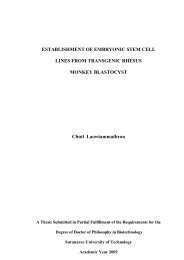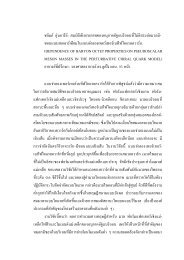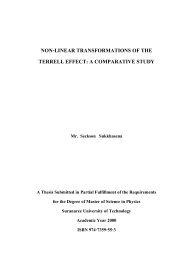PRODUCTION Of NUTRIENT SOURCES FOR RHIZOBIUM
PRODUCTION Of NUTRIENT SOURCES FOR RHIZOBIUM
PRODUCTION Of NUTRIENT SOURCES FOR RHIZOBIUM
You also want an ePaper? Increase the reach of your titles
YUMPU automatically turns print PDFs into web optimized ePapers that Google loves.
1.2�Classification of yeasts<br />
Mankind has been concerned with fermentations for at least 8,000 years. The ancient people<br />
of Sumaria, Babylon, and Ur documented beer making in their artwork, and somewhat later (~ 4,000<br />
B. C.), the Egyptians depicted the baking of leavened bread. Although these processes were<br />
eventually used world wide, it was not until 1837 that independent studies by Cagniard de la Tour,<br />
Schwann, and Kutzing show yeasts to be responsible for fermentation. S. cerevisiae was the species<br />
generally used in baking and brewing, but there were about 600 known yeast species and certain<br />
others are also important commercially.<br />
The yeasts are a phylogenetically diverse group of fungi whose teleomorphs or sexual states<br />
are found among two major taxonomic classes, the Ascomycotina and the Basidiomycotina.<br />
Consequently, the term “yeast” is one of convenience that describes predominantly unicellular<br />
organisms that undergo vegetative cell division either by budding or by fission. Furthermore, in<br />
contrast to higher fungi, the sexual state of a yeast is not enclosed in a fruiting body (Verachtert et al.,<br />
1990).<br />
1.2.1 Ascomycetous yeasts<br />
Historically, ascomycetes have been placed in two taxonomic classes, or as subclasses<br />
in some treatments, the Hemiascomycetes and the Euascomycetes. Hemiascomycetes are<br />
characterized by asci that are not enclosed within a fruiting body (ascocarp), whereas Euascomycetes<br />
usually form asci within or upon fruiting bodies. Budding yeasts, fission yeasts and yeastlike genera<br />
such as Ascoidea, Cephaloascus, and Taphrina are assigned to the Hemiascomycetes, but taxonomic<br />
treatment of yeasts typically exclude the yeastlike taxa.<br />
Earlier proposals for the ascomycetous yeast have been summarized by Lodder (1970)<br />
and Kreger-van Rij (1984). Those systems were mostly based on type of vegetative cell division,<br />
ploidy and morphology of ascospores. Another aspect of classification is whether the ascomycetous<br />
yeasts represent primitive organisms, as is suggested by their appearance, or whether they are reduced<br />
forms derived from various more advanced fungal lineages. Cain (1972) proposed that yeasts<br />
represent reduced forms, citing the hat–shaped (galeate) ascospores common to Pichia (Hansenula),<br />
Cephaloascus, and Ceratocystis as evidence of an adaptation that would have occurred just once in<br />
��






